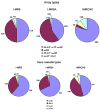Class 1 integron in staphylococci
- PMID: 21258866
- PMCID: PMC3136644
- DOI: 10.1007/s11033-011-0676-7
Class 1 integron in staphylococci
Abstract
As a major concern in public health, methicillin-resistant staphylococci (MRS) still remains one of the most prevalent pathogens that cause nosocomial infections throughout the world and has been recently labeled as a "super bug" in antibiotic resistance. Thus, surveillance and investigation on antibiotic resistance mechanisms involved in clinical MRS strains may raise urgent necessity and utmost significance. As a novel antibiotic resistance mechanism, class 1 integron has been identified as a primary source of antimicrobial resistance genes in Gram-negative organisms. However, most available studies on integrons had been limited within Gram-negative microbes, little is known for clinical Gram-positive bacteria. Based on series studies of systematic integrons investigation in hundreds of staphylococci strains during 2001-2006, this review concentrated on the latest development of class 1 integron in MRS isolates, including summary of prevalence and occurrence of class 1 integron, analysis of correlation between integron and antibiotic resistance, further demonstration of the role integrons play as antibiotic determinants, as well as origin and evolution of integron-associated gene cassettes during this study period.
Figures
References
-
- Ahmed AM, Nakano H, Shimamoto T. Molecular characterization of integrons in non-typhoid Salmonella serovars isolated in Japan: description of an unusual class 2 integron. J Antimicrob Chemother. 2005;55:371–374. - PubMed
-
- Ben-Ami R, Navon-Venezia S, Chwartz D, Carmeli Y. Infection of a ventriculoatrial shunt with phenotypically variable Staphylococcus epidermidis masquerading as polymicrobial bacteremia due to various coagulase-negative staphylococci and Kocuria varians. J Clin Microbiol. 2003;41:2444–2447. - PMC - PubMed
Publication types
MeSH terms
Grants and funding
LinkOut - more resources
Full Text Sources
Research Materials





